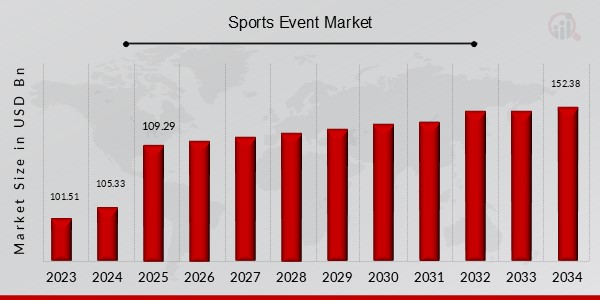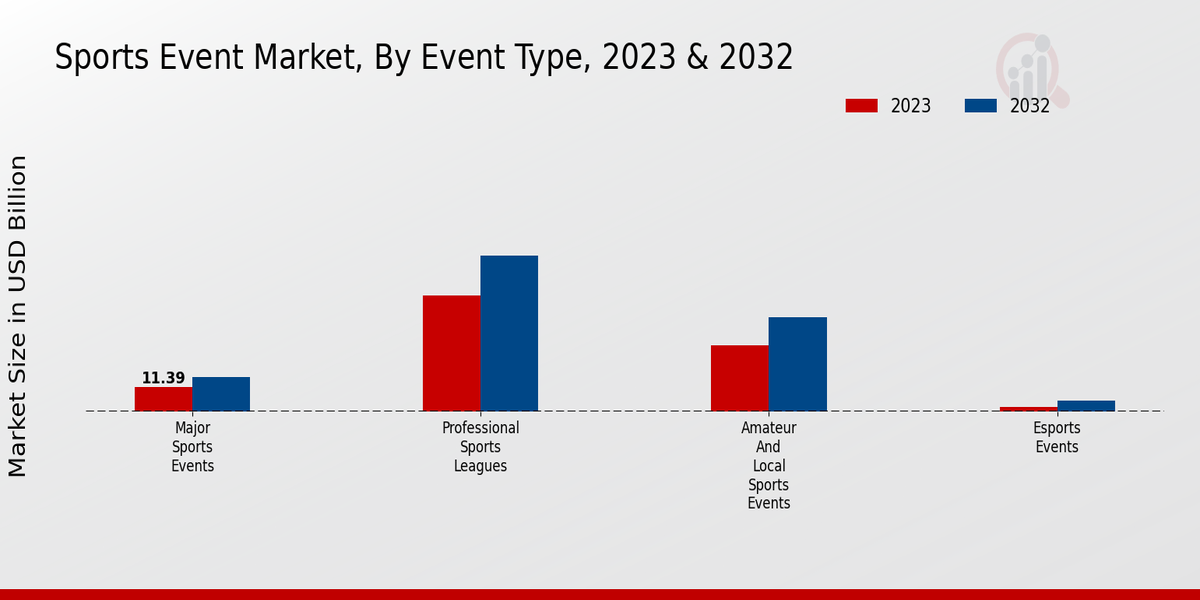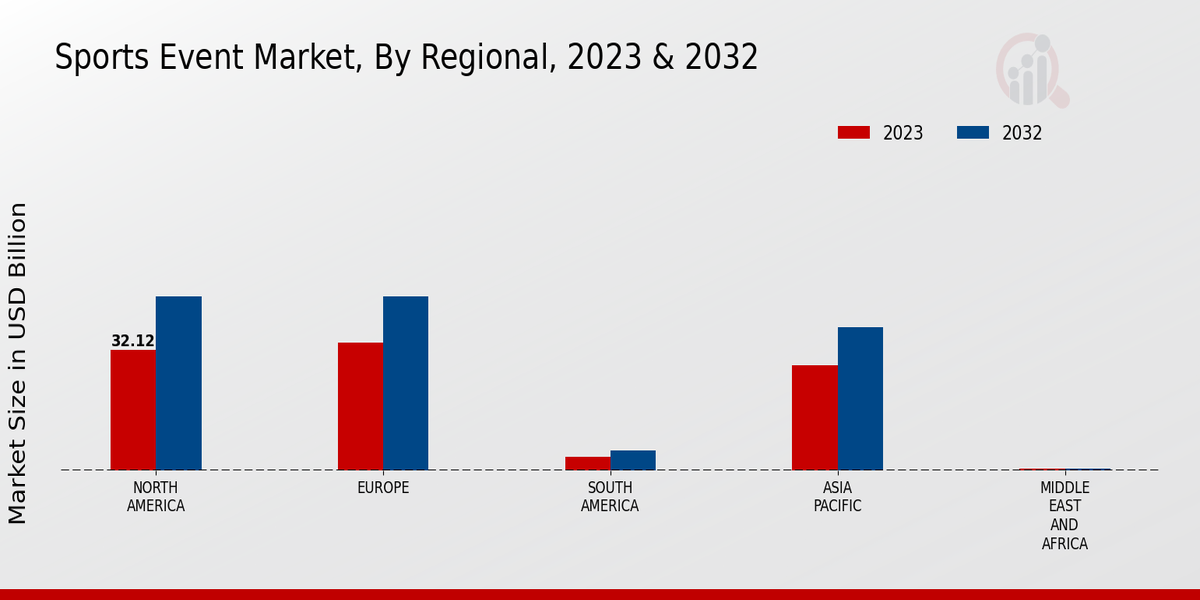Global Sports Event Market Overview
Sports Event Market Size was estimated at 105.33 (USD Billion) in 2024. The Sports Event Market is expected to grow from 109.29 (USD Billion) in 2025 to 152.38 (USD Billion) by 2034. The Sports Event Market CAGR (growth rate) is expected to be around 3.8% during the forecast period (2025 - 2034).

Source Primary Research, Secondary Research, MRFR Database and Analyst Review
Key Sports Event Market Trends Highlighted
The tendencies of the Sports Event Market are attributed to rising personal incomes, the emergence of health awareness and the inclination towards sports. Propagation of television and other digital media has also aided the expansion of the market. Consequently, the most prominent trend has been the increasing use of advanced technologies in order to improve the fan experience and attract more fans to events. Virtual, Augmented reality, artificial intelligence and blockchain incorporation come into play.
In the emergent markets, there is an opportunity to establish different appeals, such as new event formats and experiences, including virtual and hybrid events. Again, the combination of environmental measures and fun into the design of activities that advocate for healthy living has great potential.
The latest trends are combining the issue of human emotional characteristics with creative approaches to events, ensuring a person-centered event experience. There is also a rise in demand for fan zones and other interactive installations for the events so as to deepen the engagement and satisfaction of the attendees. In addition to this, there has been an increasing emphasis on sustainable event management practices that include waste reduction practices and environment-consciousness by the event organizers and sponsors.
Sports Event Market Drivers
Rising Popularity of Spectator Sports
One of the most important factors driving the growth of the sports event market industry is the increasing popularity of spectator sports. There are several reasons for this, including the fact that there is much more sports content available on television and online than ever before. In addition, fantasy sports are becoming increasingly popular, and there are more and more people who are interested in going to live sports events. As a result of all of these factors, demand for sports events is increasing.
Growth of the Sports Tourism Industry
Another major driver of the Sports Event Market Industry is the growth of the sports tourism industry. More and more people are traveling to attend sporting events. This is especially the case with major sporting events, such as the Olympics and the World Cup. As this industry grows, the demand for sports events also grows, leading to an increase in the sports event market.
Increasing Corporate Sponsorship of Sports Events
Another key driver of the Sports Event Market Industry is the growing trend of corporate sponsorship of sports events. This is being driven by a number of factors, including the fact that corporations increasingly realize the value of sponsoring sports events as a means of reaching a large audience and promoting their products and services. As a result, the demand for sports events is on the rise, which is driving growth in the Sports Event Market Industry.
Sports Event Market Segment Insights
Sports Event Market Event Type Insights
The Event Type segment of the Sports Event Market is expected to grow as the popularity of sports and demand for live entertainment continue to rise. Major Sports Events include the Olympics, FIFA World Cup or UEFA Champions League, which garner worldwide attention and involve considerable revenues from ticket sales, sponsorships and broadcasting rights. Professional Sports Leagues such as the NFL or NBA and the Premier League in the UK are also a mainstay in this market, as their regular season or playoffs attract millions of viewers.
Amateur and Local Sports Events are essential to develop grassroots sports and involve communities, as they create competitions in all sports for people of all ages or skill levels. Esports Events is a rapidly-growing segment, as professional and amateur videogaming is increasingly popular and is seen on mediums such as YouTube and Twitch or is broadcast from arenas. Finally, other event types include marathons, bike races, and adventure races as the popularity of endurance or outdoor sports increases. By choosing to segment the Sports Event Market by a characteristic of this event, many insights are gained on the diversity of this market.
Different types of events require different preparations, sales or marketing strategies, and goods or services, and by choosing the right segment, stakeholders may exploit all insights into better advertising and higher revenues.

Source Primary Research, Secondary Research, MRFR Database and Analyst Review
Sports Event Market Event Scale Insights
The Event Scale segment plays a crucial role in shaping the Sports Event Market revenue. It is segmented into Events, Regional Events, National Events, Local Events, and Virtual Events. Events holds the largest market share, driven by the participation of renowned athletes, extensive media coverage, and sponsorships. Regional Events cater to specific geographical regions, attracting significant crowds and generating substantial revenue. National Events focus on domestic competitions, fostering national pride and engaging local communities.
Local Events hold immense importance at the grassroots level, promoting sports participation and community involvement. Virtual Events have gained traction in recent years, offering accessibility to audiences and reducing geographical barriers. Each Event Scale segment exhibits unique growth opportunities and challenges, influencing the overall market segmentation and dynamics.
Sports Event Market Event Format Insights
The Sports Event Market is segmented by event format into live events, hybrid events, virtual events, spectator events, and participation events. Among these segments, live events held a significant share of the market revenue in 2023 and are expected to maintain their dominance throughout the forecast period, owing to the immersive and engaging experience they offer to attendees. Hybrid events, which combine live and virtual elements, are also gaining popularity as they provide a wider reach and flexibility to participants. Virtual events, leveraging technology, allow for remote participation from anywhere in the world, making them a cost-effective option.
Spectator events, involving professional athletes or teams, attract large audiences and generate significant revenue through ticket sales, merchandise, and sponsorships. On the other hand, participation events, where individuals actively participate in sports activities, foster community engagement and promote healthy lifestyles. The growth of the overall sports event market is driven by factors such as increased participation in sports, technological advancements, and the rising popularity of sports tourism.
Sports Event Market Revenue Source Insights
The Sports Event Market revenue is segmented into various sources, including ticket sales, sponsorship, media rights, merchandise sales, and hospitality and VIP packages. Ticket sales account for a significant portion of the market, owing to the growing popularity of live sporting events and the increasing demand for premium seating options. Sponsorship is another major revenue source, as brands seek to align themselves with high-profile sporting events to reach a wider audience. Media rights contribute a substantial share of the market revenue, driven by the increasing consumption of live sports content across various platforms.
Merchandise sales, such as team jerseys, memorabilia, and accessories, also generate significant revenue for sports events. Hospitality and VIP packages offer premium experiences for attendees, including exclusive access to events, meet-and-greets with athletes, and luxurious amenities, contributing to the overall revenue of the Sports Event Market.
Sports Event Market Target Audience Insights
The target audience for the Sports Event Market is diverse, encompassing various stakeholders who play significant roles in the industry's growth. Fans and spectators constitute a vast segment, driving the demand for tickets, merchandise, and related experiences, contributing to the market's revenue. Athletes and participants form the core of sports events, showcasing their skills and competing for recognition and accolades. Media and broadcasters play a crucial role in disseminating event coverage, reaching a audience and generating advertising revenue.
Sponsors and exhibitors leverage sports events for brand exposure, customer engagement, and lead generation, contributing to the overall market growth. Event organizers are responsible for planning, coordinating, and executing sports events, ensuring their smooth operation and success. Each segment offers unique opportunities and challenges, influencing the Sports Event Market's segmentation and dynamics.
Sports Event Market Regional Insights
The regional segmentation of the Sports Event Market offers valuable insights into the market's growth dynamics and opportunities. North America dominates the market, capturing a significant share of the Sports Event Market revenue due to the presence of major sports leagues, such as the NFL, NBA, and MLB, and a strong sporting culture. Europe follows closely, driven by the popularity of soccer, tennis, and other major sporting events. The Asia-Pacific (APAC) region is projected to exhibit the highest growth potential, fueled by the increasing popularity of sports and the rise of emerging economies like China and India.
South America and the Middle East and Africa (MEA) regions also contribute to the Sports Event Market growth, driven by the growing popularity of sports events and government investments in sports infrastructure.

Source Primary Research, Secondary Research, MRFR Database and Analyst Review
Sports Event Market Key Players And Competitive Insights
Major players in the Sports Event Market industry are constantly seeking ways to enhance their competitive advantage by exploring new market opportunities and developing innovative products and services. Leading Sports Event Market players are investing heavily in research and development to create more immersive and engaging experiences for spectators and participants. Strategic partnerships, collaborations, and acquisitions are also common strategies employed by top players to expand their market reach and strengthen their position in the competitive landscape. The development of the sports event market is being driven by technological advancements, such as the use of virtual reality and augmented reality to enhance the fan experience. Companies are also focusing on sustainability initiatives to reduce their environmental impact and cater to the growing demand for eco-friendly events.
IMG is a leading Sports Event Market player with a strong track record of organizing and managing iconic sporting events worldwide. The company has a network of partners and clients, and it has organized major events such as the Olympics, the FIFA World Cup, and the Wimbledon Championships. IMG's expertise in event management, broadcasting, and marketing enables it to deliver exceptional experiences for both spectators and sponsors. The company is committed to innovation and sustainability, and it continuously invests in new technologies and practices to enhance its operations.
A key competitor in the Sports Event Market is Endeavor, a sports and entertainment company. Endeavor owns and operates a portfolio of major sports properties, including the Ultimate Fighting Championship (UFC), Professional Bull Riders (PBR), and Miss Universe Organization. The company also provides talent representation, event management, and content production services to clients across the world. Endeavor's focus on creating premium live experiences and its strategic partnerships with broadcasters and sponsors have contributed to its success in the industry.
Key Companies in the Sports Event Market Include
-
Live Nation Entertainment
-
Oak View Group
-
ASM Global
-
The Cordish Companies
-
Zwift
-
AEG Worldwide
-
Madison Square Garden Company
-
WME Sports
-
World Wrestling Entertainment
-
Feld Entertainment
-
Topgolf Golf Entertainment Group
-
Populous
-
Relevant Sports
Sports Event Market Industry Developments
The Sports Event Market is projected to reach USD 136.4 billion by 2032, exhibiting a CAGR of 3.76% during the forecast period. The rise in popularity of sports betting, the growing adoption of digital technologies, and the increasing number of sports events are driving the market growth.
Recent news developments in the market include
In 2023, the International Olympic Committee (IOC) announced plans to explore virtual and augmented reality technologies for future Olympic Games.
In 2024, FIFA announced the expansion of the FIFA World Cup to 48 teams, starting from the 2026 tournament.
In 2025, the National Football League (NFL) launched its own streaming service, NFL+, offering live and on-demand content.
These developments highlight the evolving landscape of the Sports Event Market, with a focus on innovation, technology adoption, and expanding viewership.
Sports Event Market Segmentation Insights
Sports Event Market Event Type Outlook
- Major Sports Events (e.g., Olympics, FIFA World Cup)
- Professional Sports Leagues (e.g., NFL, NBA, Premier League)
- Amateur and Local Sports Events
- Esports Events
- Other (e.g., marathons, bike races)
Sports Event Market Event Scale Outlook
- Events
- Regional Events
- National Events
- Local Events
- Virtual Events
Sports Event Market Event Format Outlook
- Live Events
- Hybrid Events (combining live and virtual elements)
- Virtual Events
- Spectator Events
- Participation Events
Sports Event Market Revenue Source Outlook
- Ticket Sales
- Sponsorship
- Media Rights
- Merchandise Sales
- Hospitality and VIP Packages
Sports Event Market Target Audience Outlook
- Fans and Spectators
- Athletes and Participants
- Media and Broadcasters
- Sponsors and Exhibitors
- Event Organizers
Sports Event Market Regional Outlook
- North America
- Europe
- South America
- Asia Pacific
- Middle East and Africa
| Report Attribute/Metric |
Details |
| Market Size 2025 |
105.33(USD Billion) |
| Market Size 2024 |
109.29(USD Billion) |
| Market Size 2034 |
152.38(USD Billion) |
| Compound Annual Growth Rate (CAGR) |
3.8%(2025 - 2034) |
| Report Coverage |
Revenue Forecast, Competitive Landscape, Growth Factors, and Trends |
| Base Year |
2024 |
| Market Forecast Period |
2025 - 2034 |
| Historical Data |
2021 - 2024 |
| Market Forecast Units |
USD Billion |
| Key Companies Profiled |
Live Nation Entertainment, Oak View Group, ASM Global, The Cordish Companies, Zwift, AEG Worldwide, Madison Square Garden Company, WME Sports, World Wrestling Entertainment, Feld Entertainment, Topgolf Golf Entertainment Group, Populous, Relevant Sports |
| Segments Covered |
Event Type, Event Scale, Event Format, Revenue Source, Target Audience, Regional |
| Key Market Opportunities |
Lucrative investment in sports infrastructure Increasing popularity of esports Growing demand for sports analytics Surge in corporate sponsorships Rise of sports tourism |
| Key Market Dynamics |
Rising event digitization, growing popularity of esports technological advancements, increasing government support, expanding sports economy |
| Countries Covered |
North America, Europe, APAC, South America, MEA |
Frequently Asked Questions (FAQ) :
The sports event market is expected to reach a valuation of USD 109.29 billion in 2025 and is projected to grow at a CAGR of 3.8% from 2025 to 2034, reaching USD 152.38 billion by 2034.
The growth of the sports event market is primarily driven by increasing participation in sports activities, rising disposable income, and the growing popularity of sports tourism. Additionally, technological advancements and the increasing use of social media platforms for promoting sports events are contributing to market growth.
North America is expected to hold the largest market share in the sports event market throughout the forecast period. The region's dominance can be attributed to the presence of well-established sports leagues, a large number of professional athletes, and a strong sporting culture.
Sports events have various applications, including entertainment, promoting physical activity, fostering community engagement, and generating revenue for businesses and organizations. They can range from small-scale local events to large-scale international competitions.
Major players in the sports event market include ESPN, NBCUniversal, IMG, Endeavor, and Lagardre Sports and Entertainment. These companies are involved in organizing, broadcasting, and managing a wide range of sports events worldwide.
Emerging trends in the sports event market include the use of virtual and augmented reality technologies to enhance fan experience, the rise of esports events, and the increasing focus on sustainability and social responsibility in event management.
The sports event market is expected to continue growing in the coming years, driven by increasing demand for sports entertainment, technological advancements, and the growing popularity of sports tourism. The market is also expected to see increased investment in sustainability and social responsibility initiatives.
The sports event market faces challenges such as intense competition, rising costs, and the need to adapt to changing consumer preferences. Additionally, the industry is affected by factors such as economic downturns, political instability, and natural disasters, which can impact event attendance and revenue generation.
Stakeholders in the sports event market can overcome challenges by adopting innovative strategies, such as leveraging technology to enhance fan engagement and exploring new revenue streams. Collaboration between organizers, broadcasters, and sponsors is also crucial to ensure successful event execution and maximize market opportunities.
Growth opportunities in the sports event market include expanding into emerging markets, developing new event formats, and targeting niche sports and demographics. Additionally, investing in technology, sustainability, and social responsibility can create competitive advantages and drive market growth.

















